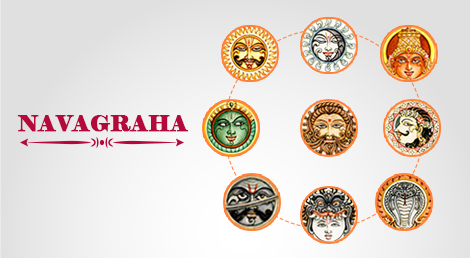Navagraha
Navagraha
Hindu Astronomy includes Navagrahas, which plays a significant role in the Hindu astronomy. The Hindu astronomy, which stretches back to the Vedic period, is concerned with the positions of nine planets and their effects on the world and individuals. The position of the planets when a person is born, according to Hindu astrology, influences his life potential.
Navagrahas is the collective name for the nine planets. Hindus worship these nine planets to help them overcome any difficulties, obstacles, or ill luck. They are mainly found in all temples, and devout believers worship to the Navagrahas first before praying to any other god.
Seven of the nine planets are named after planets in the Solar System, but the other two, Rahu and Ketu, are actually devils who got into this group by deception. They are classified as auspicious or inauspicious depending on where they are in the solar system. While Navagrahas can be found in every temple, some temples are dedicated specifically to them. The Navagraha temple, located on the outskirts of Ujjain, is one such temple.
Significance of the navagrahas as per astrology
Everything in the universe, according to astrology, has an impact on others. The gravitational attraction of the Moon, for example, generates tides in Earth's oceans. Astrology is based on the idea that celestial beings have an impact on everything in the cosmos, from the tiniest to the largest items. Humans are included in this.
Each navagraha has the power to influence several elements of our existence.
Name and positions in navagraha
Sun (Surya): He is usually depicted facing east and standing in the centre of a collection of other planets. The planets that surround him are all facing various directions, but not at each other. He rides a single-wheeled chariot drawn by seven horses, representing the seven colours of white light and the seven days of the week. Ravi is another name for him.
Moon (Chandra): He is never depicted as a whole person in the photographs. Only his upper body is seen, with two hands each clutching a lotus and riding a chariot drawn by ten horses. Soma is another name for him.
Mars (Mangala): Mangala is a ferocious God who wields two weapons and has two mudras. His mode of transportation is a ram.
Mercury (Budha): Budha is a four-handed being who rides a chariot or a lion. Three of his hands are holding a sword, a shield, and a mace, while the fourth is in a mudra.
Jupiter (Brihaspathi): In the Rig Veda, he is praised as a God's teacher. He is depicted riding a chariot drawn by eight horses, each representing a different branch of knowledge.
Venus (Sukra): Sukra is the Demons' instructor. He has four hands and is pulled by eight horses in a chariot. Three of his hands are holding a stick, a rosary, and a gold vessel, while the fourth is in a mudra.
Sani (Saturn): Sani is a god who has the power to make or shatter fortunes based on his planetary position, and people fear him. With four hands, he is seen riding a chariot, a buffalo, or even a vulture. He has three hands, one of which is holding an arrow, the other a bow, and the other a mudra.
Rahu: He resembles Budha (Mercury) in appearance, but their natures are fundamentally different. Budha is seen riding a black lion, just as he is shown riding a white lion. However, he wields all of the same weapons as Budha.
Ketu: Ketu signifies comet in Sanskrit. He is said to have a serpent's tail in his body, and his nature is similar to that of a comet. He is depicted riding a vulture and wielding a mace in photographs.
What are the nine navagrahas?
The nine grahas, generally known as the navagrahas (nava meaning nine), are the focus of Vedic astrology. They include the sun (Surya), moon (Chandra), Mars (Mangala), Mercury (Budha), Jupiter (Brihaspati), Venus (Shukra), Saturn (Shani), Rahu (north node of the moon), and Ketu (south node of the moon).
Navagraha impacts on astrology
Navagrahas influence a person's happiness, success, and overall prosperity in Hindu Astrology. The good and bad, positive and negative influences of each of these nine planets are determined by elements such as the planets' exact positions in the birth chart, among other things. Jupiter, the Sun, and the Moon are all Sattva planets. Venus and Mercury are Rajas planets, whereas Mars, Saturn, Rahu, and Ketu are Tamas planets.
In vedic astrology, these nine planets are viewed as deities with distinct abilities, natures, and characteristics based on what each of them has to contribute – positive or negative – to individuals.
Navagraha benefits in life
The Navagraha Pooja is a powerful and time-tested Vedic ceremony that can help a person achieve good health, education, and knowledge, as well as massive money, household peace and prosperity, and all-around success and acclaim in life. This navagraha Pooja, or devotion, is essentially a collective worship of the Vedic or Hindu astrology's nine planets.
· This Puja encourages bravery and strength, as well as triumph over adversaries, success, and prosperity.
· This Puja brings mental calm, prosperity, fame, a charming personality, and life success.
· Navgraha Puja brings great health, money, prosperity, and power into one's life.
· Wisdom, wealth, business success, and relief from nervous system disorders will all be yours.
· All bad effects of all planets in your birth chart will be removed with this pooja.
-
Talk to Astrologer On Call
Starting from 12 per minute only
-
Get Detailed Manual Report
Starting from 250 only
-
Read Article
Read Astrology Articles
- Vedic Astrology,...
- Exp - 12 Years
- English, Hindi
- K.P. Astrology, V...
- Exp - 25 Years
- English, Hindi
- Vedic Astrology
- Exp - 25 Years
- English, Hindi



